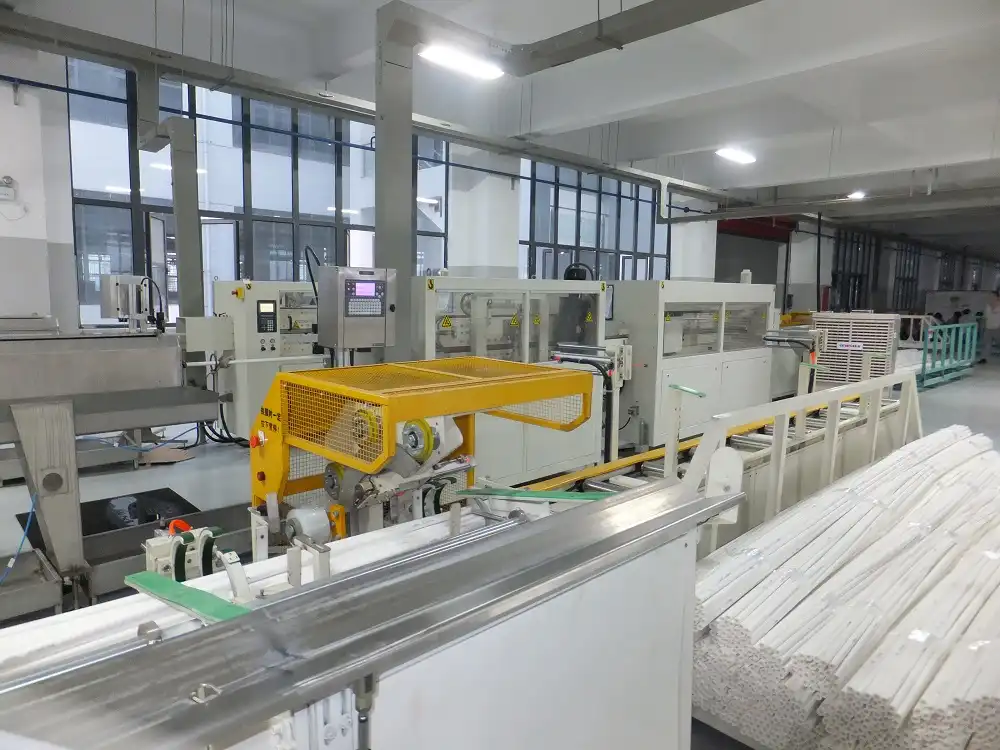Enhancing Protection and Efficiency: Shrink Wrapping Systems for Carpet and Curtain Rolls
Packaging long, bulky items like carpet and curtain rolls presents unique challenges in manufacturing and distribution environments. Ensuring these products remain clean, protected from moisture and damage, and easy to handle requires a robust packaging solution. Automated shrink wrapping machines offer an effective method to address these needs, improving both product integrity and operational efficiency.
Visual demonstration of a roll shrink wrapping machine in operation.
Understanding Shrink Wrapping for Textile Rolls
Shrink wrapping involves enveloping a product, such as a carpet or curtain roll, in a thermoplastic film. Heat is then applied, causing the film to shrink tightly around the product, creating a secure, protective layer. This method is widely used for its versatility and the high level of protection it provides against dust, dirt, and moisture.
Key Equipment: The Automated Shrink Packing Machine
Modern shrink packing machines designed for carpet and curtain rolls automate several steps of the packaging process. These systems can be configured as standalone (offline) units or integrated directly into a production line (inline) for continuous flow. Key functions typically include:
- Automatic Roll Feeding: Transporting rolls into the wrapping station.
- Film Application: Dispensing and enveloping the roll with shrink film.
- Sealing: Creating secure seals, often on the ends of the roll.
- Cutting: Trimming excess film precisely.
- Shrinking: Conveying the wrapped roll through a heat tunnel where controlled hot air shrinks the film uniformly.
These integrated functions streamline the packaging process, reducing manual handling and increasing throughput.
Choosing the Right Shrink Film
The most common material used for shrink wrapping industrial products like carpet and curtain rolls is Polyethylene (PE) shrink film. Key characteristics make it suitable for this application:
- Durability: Offers good tear and puncture resistance.
- Strength: Can handle the weight and bulk of large rolls.
- Flexibility: Conforms well to the cylindrical shape during shrinking.
- Chemical Inertness: Does not react with most textile materials.
- UV Resistance: Options are available with UV inhibitors for products stored outdoors.
Selecting the appropriate film gauge (thickness) depends on the weight and handling requirements of the rolls.
The Automated Shrink Wrapping Process
While specific machine designs vary, the general automated process follows these steps:
- Infeed: Carpet or curtain rolls are fed onto the machine's conveyor system.
- Film Envelopment: The machine automatically wraps the roll with the selected polyethylene shrink film.
- Sealing & Cutting: Sealing bars create airtight seals (typically end seals for rolls), and cutters trim away excess film.
- Heat Tunnel Conveyance: The loosely wrapped roll moves into a shrink tunnel.
- Controlled Shrinking: Inside the tunnel, precisely controlled hot air circulates around the roll, causing the film to shrink evenly and tightly conform to the product's shape.
- Cooling & Outfeed: The tightly wrapped roll exits the tunnel and cools, solidifying the film's shape for a secure package ready for handling, storage, or shipping.
Benefits of Automated Shrink Wrapping for Rolls
Implementing an automated shrink wrapping system offers significant advantages:
- Enhanced Product Protection: Creates a tight, water-resistant barrier against dirt, dust, moisture, and handling scuffs.
- Improved Load Stability: Securely unitizes the roll, preventing unwinding or loosening.
- Operational Efficiency: High-speed automation significantly increases packaging throughput compared to manual methods.
- Labor Cost Savings: Reduces the need for manual labor in the packaging process.
- Material Optimization: Automated systems use film more efficiently, potentially reducing material consumption and waste.
- Professional Presentation: Provides a clean, consistent, and professional look for finished goods.

automatic pipe bundle strapping machine5 Implementation Considerations
When considering an automated shrink wrapping system, factors to evaluate include:
- Roll Dimensions: Ensure the machine can handle the range of diameters, lengths, and weights required.
- Throughput Needs: Match the machine's speed to production output.
- Space Availability: Account for the footprint of the machine, including the shrink tunnel.
- Integration: Determine if an inline or offline system best suits the existing workflow.
- Film Type: Confirm compatibility with the desired polyethylene shrink film specifications.
For further details on specific solutions:
Links: http://www.fhopepack.com/Industry%20Solution/Textile_packing_solution.html
By carefully selecting and implementing the right shrink wrapping equipment and materials, manufacturers can effectively protect their carpet and curtain roll products while streamlining their end-of-line packaging operations.